Excerpts from Jim Conrad's
Naturalist Newsletter
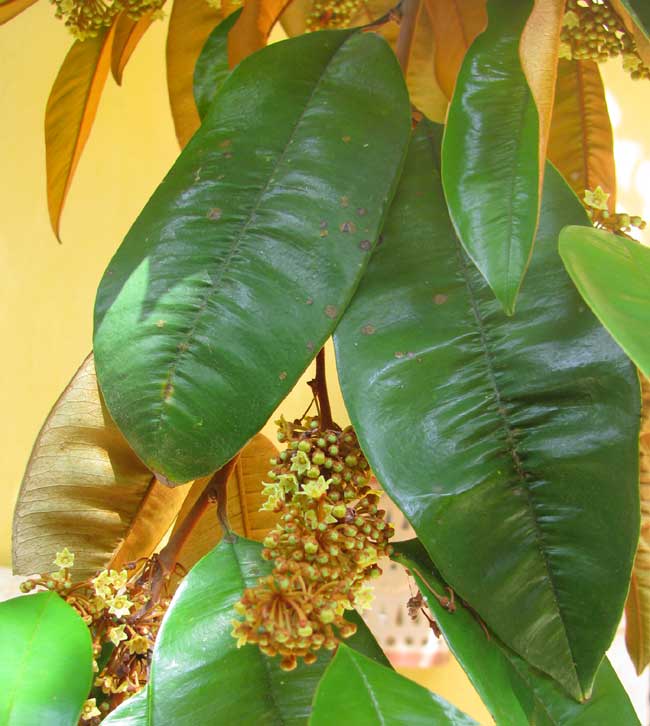
from the August 29, 2010 Newsletter issued from Hacienda Chichen Resort beside Chichén Itzá Ruins, central Yucatán, MÉXICO; limestone bedrock, elevation ~39m (~128ft), ~N20.676°, ~W88.569°
STAR-APPLE FLOWERING
Next to the Hacienda's bathroom the big Star-Apple tree, CHRYSOPHYLLUM CAINITO, with its five-inch-long (13 cm), evergreen leaves -- glossy green above and silky golden-brown below -- is flowering. Its leaves and 3/16ths-inch-long (4 mm) flowers are shown above.
Besides being a very shapely, fair-sized tree (up to 50 feet, or 15 m) with unusually attractive leaves, the main thing about Star-Apples is their fruits, which are apple-sized, spherical, covered with a smooth purple or light green skin, and contain a translucent, whitish pulp with 3-8 shining seeds. And that flesh is very tasty. Star-Apple fruits were falling about a month ago, but they all hung too high to photograph, and the ones that fell were all half- eaten by Kinkajous, so I missed showing them to you.
Still, the current flowers are worth looking at. You can see one much magnified below:
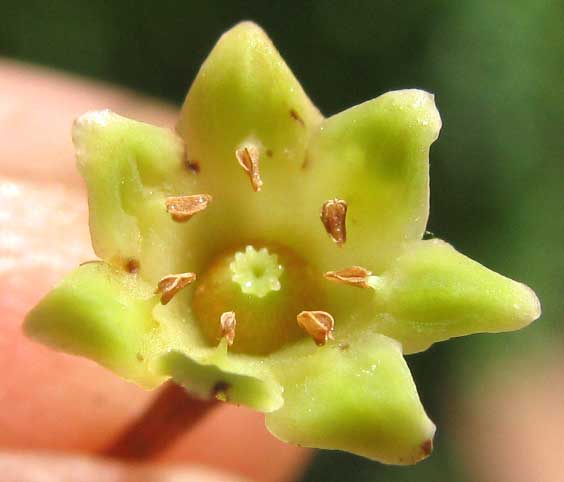
Books say that Star-Apple flowers have five corolla lobes and stamens but you can see that this one, picked at random, bears seven of each. In the first photo you can make out that there's a general mix of five-lobed, six-lobed and seven-lobed flowers in the inflorescences. Well, Star-Apples have been cultivated for a long time and it often happens among cultivars of long standing that genes get a bit scrambled and funny things occur -- random spots on cattle, for instance, and flowers with seven corolla lobes.
Another unusual thing about the blossom shown in the close-up is that its pollen-producing stamens arise opposite the corolla lobes, at their bases. Stamens in most flowers alternate with their corolla lobes. Also, it's a little unusual for stamens to simply arise from a corolla wall instead of beneath the ovary.
However, having stamens exactly like these is a general feature of the family to which Star-Apples belong, the Sapodilla Family, the Sapotaceae. Other members of that family include the Chicozapote or Chicle tree, the Mamey, and Canistel, all trees producing large, delicious fruits much sought in tropical markets.
Star-Apples are native tropical American trees planted widely throughout the Earth's tropics.
from the March 4, 2012 Newsletter issued from Hacienda Chichen Resort beside Chichén Itzá Ruins; limestone bedrock; elevation ~39m (~128ft), N20.675°, W88.569°; central Yucatán state, MÉXICO
STAR-APPLES FRUITING
Below you can see ripe, purple-skinned, 3½-inch-across (9cm) fruits currently hanging on a tree in Dzitas.
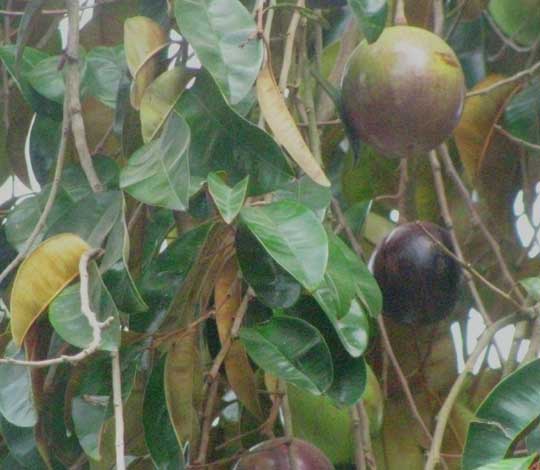
Even if you don't recognize the fruits, the tree's leaves, so green and shiny on top and richly golden-brown below are so distinctive that Star-Apple trees are easy to recognize. The fruits contain a translucent, whitish pulp surrounding three to eight shining seeds.
from the March 18, 2012 Newsletter issued from Hacienda Chichen Resort beside Chichén Itzá Ruins; limestone bedrock; elevation ~39m (~128ft), N20.675°, W88.569°; central Yucatán state, MÉXICO
EATING A STAR-APPLE
In Pisté, Star-Apple fruits now are showing up for sale. You can see one I bought and sliced open below:
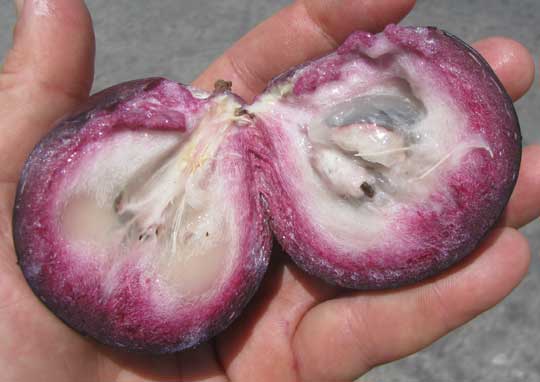
At first I tried breaking the fruit apart with my thumbs but it was so full of white, sticky, milky latex that I made a mess. Then I used a knife. If I had cut the fruit across the middle we could have seen the "star" formed by the 3-8 seeds, but I made a longitudinal section showing entire black seeds clustering in the fruit's center.
Star-Apples are sweet and juicy, and their juice is so sticky that afterwards your lips slightly stick together, and things stick to your fingers. The skin is just tough enough to make you wonder whether to eat it or not. If I hadn't worried about chemical residues on the skin, I'd have eaten it.
from the March 25, 2018 Newsletter issued from Rancho Regensis north of Valladolid, Yucatán, MÉXICO;
elevation ~40m (~130 ft), N~20.876°, W~88.170°
THE STAR-APPLE'S STAR
Nowadays our Star-Apple trees are producing nicely, I'm eating my share and, below, you can see the star in the apple, which we failed to notice earlier:
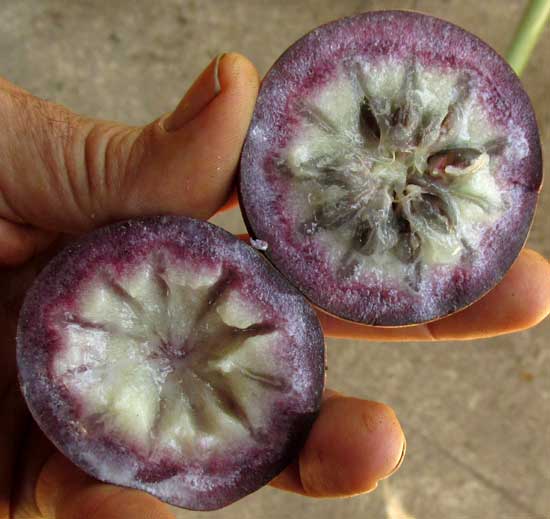
The Star-Apple fruit technically is considered to be a berry because it's fleshy, doesn't split at maturity, and contains more than one seed. The ovary that produced this fruit was divided into eleven cells, or carpels, with one ovule in each carpel. Then the ovary matured into our fruit, and each ovule in its carpel developed into a hard, brown seed.